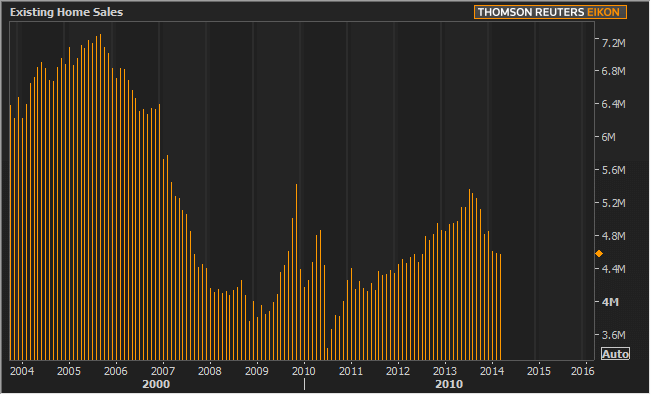Sales of existing homes were essentially unchanged in March compared to February the National Association of Realtors® (NAR) said today. Home prices continued to increase in March but the growth has now slowed from previous double-digit levels.
NAR said total existing home sales in March were at a seasonally adjusted annual rate of 4.59 million homes, down 0.2 percent from a rate of 4.60 million homes in February. This is a 7.5 percent decline from the 4.96 million unit pace in March 2013. The March annual sales rate tied the most recent previous low reached in July 2012.

Single-family home sales were unchanged from February at a seasonally adjusted annual rate of 4.04 million but are 7.3 percent below the 4.36 million pace the year before. Existing condominium and co-op sales declined 1.8 percent to an annual rate of 550,000 units in March from 560,000 in February, and are 8.3 percent below the 600,000 level of March 2013.
Lawrence Yun, NAR's chief economist said that home sales are underperforming by historical standards. "There really should be stronger levels of home sales given our population growth. In contrast, price growth is rising faster than historical norms because of inventory shortages." Yun does expect improvement, however. "With ongoing job creation and some weather delayed shopping activity, home sales should pick up, especially if inventory continues to improve and mortgage interest rates rise only modestly," he said.
The median existing-home price for all housing types in March was $198,500, up 7.9 percent from March 2013. Single-family homes brought a median sales price of $198,200, 7.4 percent higher than a year earlier. The median existing condo price was $200,800 representing an 11.6 percent annual increase.
Foreclosed properties had a 10 percent market share and short sales accounted for 4 percent of homes sold. The combined share of distressed property sales was down from 16 percent in February and 21 percent in March 2013. Yun said that rising home equity should bring the market share of distressed sales down to single digits later this year.
Foreclosures sold for an average discount of 18 percent from full market value during the month. Short sales were discounted an average of 12 percent.
The housing inventory is improving with 1.99 million existing homes available for sale at the end of March, a 5.2 month supply at the current rate of sale. The inventory is 4.7 percent higher than in February and 3.1 percent above a year earlier when there was a 4.7 month supply.
Existing homes were on the market a median of 55 days in March compared to 62 days both in February and in March 2013. Short sales required a median of 112 days to close while foreclosures took 55 days. Market properties sold in a median of 53 days. Thirty-seven percent of homes sold in March were on the market for less than a month.
First-time buyers accounted for 30 percent of purchases in March, the same as a year earlier but 2 percentage points more than in February. Individual investors purchased 17 percent of the homes sold, down from 21 percent the previous month and 19 percent a year earlier and one-third of sales were all cash as were 71 percent of investor sales.
NAR President Steve Brown said first-time buyers have been stuck in a rut. "There are indications that the stringent mortgage underwriting standards are beginning to ease a bit, particularly regarding credit score requirements, but they remain a headwind for entry-level and single-income home buyers," he said.
"We also have tight inventory in the lower price ranges where many starter homes are found, but rising new-home construction means some owners will be trading up and more existing homes will be added to the inventory. Hopefully, this will create more opportunities for first-time buyers," Brown said.
On a regional basis, strong sales in the Northeast and Midwest were offset by declines in the West and South. Sales in the Northeast rose 9.1 percent to an annual rate of 600,000, 4.8 percent below March 2013. The median price in the Northeast was $244,700, up 3.2 percent from a year ago.
Existing-home sales in the Midwest rose 4.0 percent in March to a pace of 1.04 million, but lagged the pace in March 2013 by 10.3 percent. The median price in the Midwest was $149,600, 5.9 percent higher than in March 2013.
In the South, existing-home sales declined 3.0 percent both month-over-month and year-over-year to an annual level of 1.92 million. The median price in the region was $173,000, up 6.7 percent from a year ago.
Existing-home sales in the West fell 3.7 percent to a pace of 1.03 million in March, and are 13.4 percent below a year ago. The median price in the West was $289,300, which is 12.6 percent higher than March 2013.
NAR's existing home sale data includes single-family, townhomes, condominiums and co-ops and is based on transaction closings from Multiple Listing Services. Changes in sales trends outside of MLSs are not captured in the monthly series.







